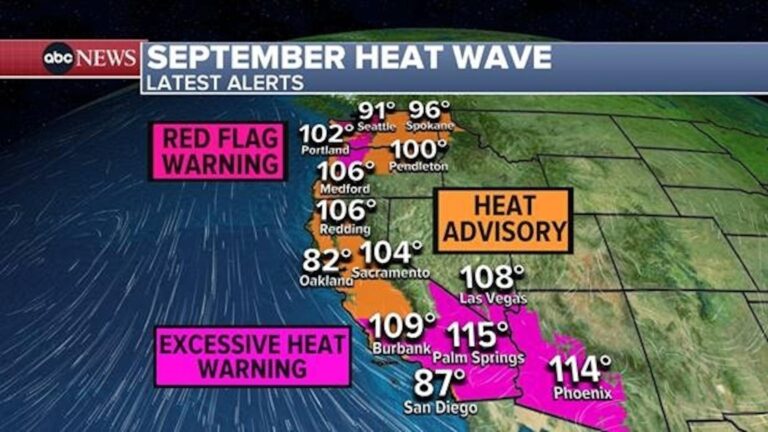Phoenix is currently grappling with an unprecedented heatwave that has pushed temperatures to staggering, record-breaking levels, prompting urgent concerns about public health and safety. The relentless sun has transformed parts of Arizona’s largest city into what many residents describe as “hell on earth,” as extreme heat tests the limits of human endurance and infrastructure. This article explores the devastating impact of the heatwave on daily life, the strain on emergency services, and the broader implications of rising temperatures in one of America‚Äôs hottest urban centers.
Phoenix Faces Unprecedented Temperatures Amid Intensifying Climate Crisis
The heart of Arizona is currently grappling with a relentless heatwave, shattering temperature records and pushing Phoenix residents to the brink. Daytime highs have soared past 118°F (48°C), turning urban landscapes into virtual ovens and intensifying the public health emergency. Hospitals are stretched thin, reporting an influx of heat-related illnesses, while vulnerable populations—such as the elderly and those without access to cooling—face heightened risks. Authorities have urged residents to stay indoors during peak heat hours and remain vigilant about hydration and heatstroke symptoms.
Experts warn that these extreme weather patterns are not isolated incidents but part of a larger, systemic climate crisis that demands swift action. Urban infrastructure is buckling under the pressure, revealing critical weaknesses in energy grids and emergency response capabilities. Key challenges include:
- Increased electricity demand leading to rolling blackouts
- Depletion of natural water reservoirs crucial for sustaining the city
- Heightened wildfire risks in surrounding desert and mountain regions
| Metric | 2024 Record | Historical Average |
|---|---|---|
| Peak Temperature | 118°F (48°C) | 106°F (41°C) |
| Days >110°F | 27 | 15 |
| Hospitalizations (Heat-related) | 350+ | 120 |
Impact on Vulnerable Communities Highlights Urgent Need for Emergency Preparedness
As the relentless heatwave in Phoenix escalates, it has become painfully clear that vulnerable communities are disproportionately impacted. Low-income neighborhoods, elderly residents, and those with pre-existing health conditions face heightened risks without adequate access to cooling resources or emergency support. Power outages and insufficient shelter options exacerbate the crisis, leaving many stranded in dangerously high temperatures that surpass 115°F in some regions. Health facilities are reporting surges in heat-related illnesses, underscoring the critical gaps in current emergency response frameworks designed to protect the most at-risk populations.
The situation calls for a multifaceted approach to emergency preparedness, prioritizing equity and accessibility. Community leaders and policymakers must accelerate initiatives including:
- Expanding access to public cooling centers and hydration stations
- Implementing targeted outreach with real-time alerts for vulnerable individuals
- Investing in resilient infrastructure that can withstand extreme weather fluctuations
- Strengthening partnerships between healthcare providers and social services
Without immediate intervention, the human toll is expected to rise sharply. The heat crisis in Phoenix serves as a stark reminder that emergency preparedness cannot be a one-size-fits-all strategy but must be deeply informed by community-specific needs.
Innovative Cooling Solutions and Infrastructure Upgrades Offer Pathways to Resilience
As Phoenix grapples with unprecedented temperatures, city planners and engineers are pioneering advanced cooling technologies designed to mitigate the impacts of relentless heat. Among these innovations are district cooling systems that harness chilled water networks, significantly reducing individual building reliance on energy-intensive air conditioning units. These systems not only enhance cooling efficiency but also lower the urban heat signature by minimizing the waste heat displaced into the atmosphere. Additionally, reflective roofing materials and strategically placed urban shade structures are transforming public and private spaces, offering reprieve where traditional methods fall short.
Critical infrastructure is also undergoing transformative upgrades to build resilience against extreme heat stress. Utilities have prioritized the fortification of electrical grids to avoid outages that become life-threatening during heatwaves. New regulations encourage property developers to integrate heat-adaptive designs, including green roofs and heat-tolerant landscaping, which contribute to localized temperature reduction. Below is a snapshot of some ongoing projects that illustrate this multifaceted approach:
| Project Name | Focus Area | Expected Completion |
|---|---|---|
| CoolGrid Phoenix | District Cooling Network | 2025 |
| ShadeWave Initiative | Urban Canopy Expansion | 2024 |
| Resilient Power Hub | Grid Modernization | 2026 |
- Reflective and cool roofing technologies to limit heat absorption.
- Green infrastructure investments for natural cooling and air quality improvement.
- Strengthened energy grids that ensure uninterrupted access to cooling resources.
Public Health Advisories Stress Hydration and Heat Safety as Lifesaving Measures
The unprecedented heatwave gripping Phoenix has prompted urgent public health advisories aimed at curbing heat-related illnesses and fatalities. Authorities implore residents to increase their water intake exponentially, emphasizing that mere thirst is not always a reliable indicator of dehydration in such extreme temperatures. Public cooling centers have been established across the city to provide accessible refuge, especially for vulnerable populations including the elderly, outdoor workers, and those with pre-existing health conditions.
Key precautions recommended include:
- Drinking at least 8 glasses of water per day, avoiding alcohol and caffeine
- Limiting outdoor activities during peak afternoon heat hours
- Wearing lightweight, loose-fitting clothing and wide-brimmed hats
- Checking on neighbors and family members regularly
| Symptom | Action |
|---|---|
| Heat exhaustion | Move to cool place, hydrate, rest |
| Heat stroke | Call 911 immediately, cool body |
Insights and Conclusions
As Phoenix endures record-breaking temperatures, the city’s struggle underscores a growing crisis facing urban centers worldwide. With infrastructure and public health systems pushed to their limits, this extreme heatwave serves as a stark reminder of the urgent need for comprehensive climate resilience measures. As scientists warn of more frequent and intense heat events, the challenges confronting Phoenix foreshadow a future where adapting to extreme heat is no longer optional but essential for survival.







